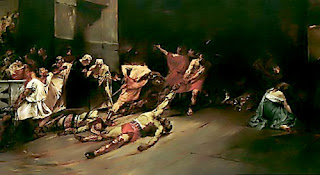Name: Spoliarium
Artist: Juan Luna
Date: 1884
Medium: Oil on poplar
Dimension: 400 x 700 cm.
Provenance: National Museum of the Philippines
When writing a critic on an artwork, you should know the basics on criticism: know the semiotics, the iconography and it’s form, the social, cultural, and historical background of the painting.
The painting depicts a dramatic historical scene where dead bodies scatter around the colosseum’s morgue. In it’s active years, the colosseum was used for gladiator battles, and executions.
The painting was done on poplar panel, a panel of wood commonly used by artists. Oil is a medium that is hard to work with because of it’s thickness, and it requires the use of a linseed for it to be able to blend the colors. Oil, too, is a popular medium used by artists because it’s easier to mix colors, and does not dry easily. Juan Luna used strong and dark hues of reds and browns to show darkness and despair, which is the theme of the painting, since it depicts a Roman morgue filled with dead bodies.
Juan Luna showed a dramatic scene as a focal point - a Roman gladiator dragging a dead body. This scene actually reminded me of the painting The Raft Of Meduse by Theodore Gericault. The scene in Juan Luna’s painting is very iconic of Theodore’s painting of the dead bodies in his Raft of Meduse. On the extreme right of the painting, we can see a woman wearing a very dark-colored teal dress showing her shoulders with her back facing the viewer. It is rather odd that this woman’s color scheme is different than those of the spectators and the gladiators. From her position, we can assume that the woman is weeping. On the left part of the painting are spectators from the arena. The human subjects are perfectly rendered, and sharp. The lighting used is exquisite, and it really gave that very dramatic feeling.
This painting would fall under the style of realism because it depicts a rather social reality than beauty; and Neoclassical because it is made in the 1800s, and it shows the perfect anatomical perspective that the Greco-Roman artists taught us.
The painting won the first gold medal in the National Exposition of Fine arts in Madrid in 1884. This honor showed Spaniards that Filipinos were not uncivilized people, thus encouraging Filipinos in Spain (J. Rizal, and M. Del Pilar among them) in their fight for reforms.


Walang komento:
Mag-post ng isang Komento